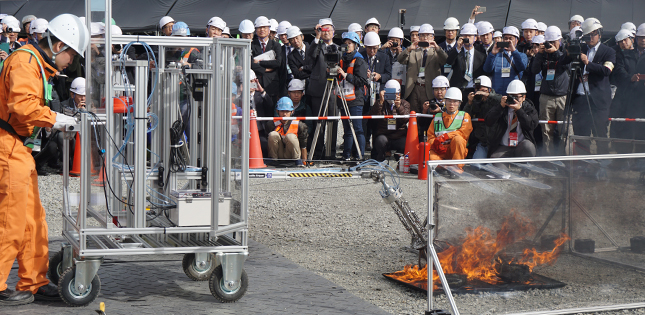https://spectrum.ieee.org/automaton...irefighting-robot-that-helped-save-notre-dameThe Paris Fire Brigade has seen its share of logistical challenges, but the massive conflagration that consumed parts of the Notre Dame cathedral on the night of 15 April required a fight of epic proportions. The cathedral is 856 years old and built in a style that makes it almost structurally impossible to contain a fire. The site doubles as both a wildly popular tourist attraction and a holy site for Christians. Defending this symbol of French heritage would require all the tactical and physical power the Brigade had at its disposal—human and otherwise.
Soon after firefighters arrived at the scene, the cathedral’s giant spire began to show signs of collapsing into the building. For onlookers, a collapse would be a devastating loss of a religious and cultural monument; for the Paris fire brigade, it would threaten the lives of the more than 400 firefighters already on the scene.
It was time to bring in the robot.
Colossus, a remote-controlled firefighting automaton designed and built by Shark Robotics, looks a bit like an army tank—if the tank were painted fire-engine red, retrofitted with a massive hose instead of a gun turret, and shrunk down to the size of a large dog. It can project water up to distances of 250 meters. With its heat- and water-resistant chassis and powerful all-terrain treads, Colossus led the way into the most dangerous areas of the cathedral, extinguishing flames and clearing away debris that could have harmed its human operators.
Install the app
How to install the app on iOS
Follow along with the video below to see how to install our site as a web app on your home screen.
Note: This feature may not be available in some browsers.
You are using an out of date browser. It may not display this or other websites correctly.
You should upgrade or use an alternative browser.
You should upgrade or use an alternative browser.
UAV / UCAV / LAR (robotit) Uutiset ja jutut
- Viestiketjun aloittaja Raveni
- Aloitus PVM

Aika tekemätön paikka on tuo Australian Suuren Valliriutan vuosittainen tutkiminen jos ei olisi drone teknologiaa. Meillä on ihan sama asia sähköverkon kanssa.
https://spectrum.ieee.org/tech-talk...-a-close-eye-on-australias-great-barrier-reefThe stats are daunting. The Great Barrier Reef is 2,300 kilometers long, comprises 2,900 individual coral reefs, and covers an area greater than 344,000 square km, making it the world's largest living organism and a UNESCO World Heritage Site.
A team of researchers from Queensland University of Technology (QUT) in Brisbane, is monitoring the reef, located off the coast of northeastern Australia, for signs of degradation such as the bleaching caused by a variety of environmental pressures including industrial activity and global warming.
The team, led by Felipe Gonzalez, an associate professor at QUT, is collaborating with the Australian Institute of Marine Science (AIMS), an organization that has been monitoring the health of the reef for many years. AIMS employs aircraft, in-water surveys, and NASA satellite imagery to collect data on a particular reef's condition. But these methods have drawbacks, including the relatively low resolution of satellite images and high cost of operating fixed-wing aircraft and helicopters.
So Gonzalez is using an off-the-shelf drone modified to carry both a high-resolution digital camera and a hyperspectral camera. The monitoring is conducted from a boat patrolling the waters 15 to 70 km from the coast. The drone flies 60 meters above the reef, and the hyperspectral camera captures reef data up to three meters below the water’s surface. This has greatly expanded the area of coverage and is helping to verify AIMS's findings.
http://www.spacedaily.com/reports/E...bles_Flying_Times_with_AMS_Cylinders_999.htmlSpecialist drone manufacturer, SKYCORP, has successfully doubled the maximum flight times of e-Drone Zero, Europe's first hydrogen powered drone, to two hours, by using a new, ultra-lightweight gas cylinder from AMS Composite Cylinders.
The e-Drone Zero is a powerful, long endurance quadcopter designed for the commercial market. It features a compact, custom military grade frame, and is powered by a unique, air cooled hydrogen fuel cell module developed by Intelligent Energy. The system is managed by one of the most advanced artificial intelligence operating systems around.
The extended range was achieved by swapping the original 1.5L cylinder, which weighed around 1kg, for AMS's innovative new 3L carbon composite cylinder. This is one of the lightest cylinders of its kind in the world today - providing double the gas capacity of the previous e-Drone Zero cylinder, whilst increasing the system weight by just 600g.
The AMS cylinder has increased the wt% H2 ratio by 17% (from 3.31 to 3.87), extending flight times of the e-Drone Zero production unit to 2 hours. This is double the 1-hour flight times achieved by the demo unit, which was unveiled in November 2018 in London at The Commercial UAV Show in London.
The e-Drone Zero can now fly 3 to 4 times longer than any Lithium-ion powered electric drones - opening up new possibilities and applications, including surveying, security, search and rescue, defence and mobile mapping.

Welcome - AMS Composite Cylinders
Welcome AMS supply state of the art lightweight gas cylinders using the latest technology. Our cylinders are used all round the world in healthcare for oxygen therapy, by emergency services for breathing air and for the emergency markets. Backed by extensive and world leading research and...
 www.ams-composites.com
www.ams-composites.com
Aiheeseen liittyvän kirjan arvostelu. En ole itse lukenut tuota.
Autonomiset asejärjestelmät haastavat ihmisten roolin sodassa

 www.ulkopolitist.fi
www.ulkopolitist.fi

Autonomiset asejärjestelmät haastavat ihmisten roolin sodassa

Autonomiset asejärjestelmät haastavat ihmisten roolin sodassa — The Ulkopolitist
Autonomiset asejärjestelmät haastavat ihmisten roolin sodassa — The Ulkopolitist

- GPS-free stabilization in dark and troubled air flows
- Distance lock to follow long and repetitive features
- A 12MP camera with a stunning 0.18 mm/px resolution
- The most powerful and intelligent lighting system ever built on a commercial drone
Elios 2 - Indoor drone for confined space inspections
Elios 2 is the most intuitive, reliable, and precise indoor inspection drone. Keep your workforce out of harm’s way while performing flawless inspections right from the first flight using cutting edge drone data capture capabilities
Robotics Program | SRI International
SRI Robotics is spearheading the robot revolution through breakthrough implementations of cutting-edge inventions.
https://spectrum.ieee.org/automaton...mingbird-is-almost-as-agile-as-the-real-thingHummingbirds are some of the most nimble fliers on Earth. Their speed and agility are spectacular, driven by the complex muscles that control their wings. This is a difficult system for robots to emulate, and in general, the small winged robots that we’ve seen have relied on compromises in control in order to be able to use flapping wings for flight.
At Purdue University’s Bio-Robotics Lab, Xinyan Deng and her students are taking a very deliberately bio-inspired approach towards winged robotic flight that has resulted in one of the most capable robotic hummingbirds we’ve ever seen. It’s just about the same size and shape as the real thing, and the researchers hope it will be able to perform the same sorts of acrobatic maneuvers as an actual hummingbird. And more importantly, it’s robust enough that it can use its wings as sensors to navigate around obstacles, meaning that it has a shot at being useful outside of a lab.
Nykyään voi saada metallilapoja ("miekkoja") sisältävän Hellfiren Reaperista kajuuttaan.
Kosla ei räjähdä entiseen tapaan, mutta sisällä on vain palapaistia. Säästää sivullisia.
Kosla ei räjähdä entiseen tapaan, mutta sisällä on vain palapaistia. Säästää sivullisia.
Viimeksi muokattu:
Einomies1
Respected Leader
Melko harhaanjohtavasti sanottu tuo "veden kuljetus" 250m päähän. Tarkoittaa siis että todennäköisesti robo kykenee vetämään 250m pitkää letkulinjaa täytenä perässä maksimissaan. Tykki on senverran pieni, että virtaama tai kantama ei ole kummoinen. Tykin käyttöpaine on videolla 3 bar, joten sekin on todella aneeminen. Vesi ei lennä todellakaan tuonne katedraalin yläosiin tai lähellekään sitä, saati että sammutus olisi edes tehokasta.
Tuolta näkemältä robotin tärkein tehtävä oli tiedustella romahtamisvaaran vuoksi ja siinä sillä on annettavaa. Kapeissa portaissa tosin tuo 500 kg mörkö on kankea ohjattava ja voi juuttua kiinni.
Paras käyttökohde minusta olisi maanalaiset tilat, kuten ajoneuvosuojat, laitesuojat ja tunnelit. Niissä tiedustelu ja pienikin vesimäärä voi auttaa jossain tilanteessa. Myös vaarallisten aineiden operaatioissa tuo robotti on hyödyllinen tiedustelussa ja haltuunotossa.
Tuolta näkemältä robotin tärkein tehtävä oli tiedustella romahtamisvaaran vuoksi ja siinä sillä on annettavaa. Kapeissa portaissa tosin tuo 500 kg mörkö on kankea ohjattava ja voi juuttua kiinni.
Paras käyttökohde minusta olisi maanalaiset tilat, kuten ajoneuvosuojat, laitesuojat ja tunnelit. Niissä tiedustelu ja pienikin vesimäärä voi auttaa jossain tilanteessa. Myös vaarallisten aineiden operaatioissa tuo robotti on hyödyllinen tiedustelussa ja haltuunotossa.
Tuo tuli viime vuonna ulos ja se on tarkoitettu juuri kemiallisiin paloihin taikka tilanteisiin mihin ihmistä ei halua lähettää. Pariisi on ollut ensimmäisten joukossa ottanut sen käyttöön, ja Notre Dame oli sille näytös mihin pystyy. Uskon, että tuon palon takia sille tehdään muutamia muutoksia.
Einomies1
Respected Leader
Joo, tuolla on kyllä paikkansa pelastustoimessa suurissa kaupungeissa, joissa on paljon rakennettua aluetta maanalla.Tuo tuli viime vuonna ulos ja se on tarkoitettu juuri kemiallisiin paloihin taikka tilanteisiin mihin ihmistä ei halua lähettää. Pariisi on ollut ensimmäisten joukossa ottanut sen käyttöön, ja Notre Dame oli sille näytös mihin pystyy. Uskon, että tuon palon takia sille tehdään muutamia muutoksia.
Olisi mielenkiintoista nähdä tuosta paljon pienennetty versio joka liikkuisi ketterämmin kuin tuo 500 kg mörkö. Colossus on mönkijän painoinen ja vaatii oman kuljetuskärryn sekä veturin. Ensivasteen toimijoille sopisi paljon pienennetty versio tiedusteluun, jonka voisi sijoittaa pelastusajoneuvoihin.
Mielenkiintoinen avaus kyllä lähes pelkkiin lennokkeihin fiksoituneille markkinoille.
Mielenkiintoinen avaus kyllä lähes pelkkiin lennokkeihin fiksoituneille markkinoille.
Maalla kulkevat autonomiset "delivery" dronet on tulossa isolla kohinalla. En ole jakanut kun ne ei ole tarpeita mitä armeija taikka viranomaiset haluavat nyt. Ne on mitä kansa tarvitsee kun ei voi enään kuskilla maksaa kotiinkuljetuksista.
Raveni
Greatest Leader
Täytyykin lukea. Kiitokset.Aiheeseen liittyvän kirjan arvostelu. En ole itse lukenut tuota.
Autonomiset asejärjestelmät haastavat ihmisten roolin sodassa

Autonomiset asejärjestelmät haastavat ihmisten roolin sodassa — The Ulkopolitist
Autonomiset asejärjestelmät haastavat ihmisten roolin sodassa — The Ulkopolitistwww.ulkopolitist.fi
Katso liite: 29701

ImPACT Tough Robotics Challenge: Final Demonstration
The ImPACT Tough Robotics Challenge wrapped up five years of research and innovation with a final public demonstration at the Fukushima Robot Test Field.
Viimeksi muokattu:
https://spectrum.ieee.org/automaton/robotics/drones/event-camera-helps-drone-dodge-thrown-objectsImpressive, right? As far as the drone is concerned, this is a clever way of mimicking obstacle encounters in high-speed flight, since it’s relative velocity that’s important. Also, the researchers say that in each case, motion capture data confirms that “the ball would have hit the vehicle if the avoidance maneuver was not executed.”
The time it takes a robot (of any kind) to avoid an obstacle is constrained primarily by perception latency, which includes perceiving the environment, processing those data, and then generating control commands. Depending on what sensor you’re using, what algorithm you’re using, and what computer you’re using, typical perception latency is anywhere from tens of milliseconds to hundreds of milliseconds. The sensor itself is usually the biggest contributor to this latency, which is what makes event cameras so appealing—they can spit out data with a theoretical latency measured in nanoseconds.

https://www.armyrecognition.com/wea...outh_korean_army_to_deploy_animal_robots.htmlBy 2024, South Korea will be ready to demonstrate its army that will include military robots, among which some will imitate various animal species, including snakes and insects, as reported by the news agency Yonhap, echoed by Lucy Tanadzhy.
According to the representative of the agency news, Park Jeong-eun, “Biometric robots will be a game changer in future warfare, and related technologies are expected to bring about great ripple effects throughout the defense industry”. The robots will be designed to perform a wide range of tasks, including search-and-rescue operations and reconnaissance. South Korean military personnel plan to work closely with domestic technology companies, positioning themselves as the world’s leading companies in the field of artificial intelligence.
In addition to the reduction of the birth rate of the Korean population, men are increasingly trying to evade compulsory military service. While some claim that this is contrary to their religious beliefs, others refer to mental illness, etc. Tattoos covering most of the body are another trick that frees South Korean citizens from military service. Today, there are just over 600,000 men with 3.1 million reservists in the South Korean armed forces, although there are about 945,000 active military personnel in neighboring North Korea with a reserve of 7.6 million. Therefore, military biorobots will be more appropriate than ever.
kimmo.j
Greatest Leader
Melko harhaanjohtavasti sanottu tuo "veden kuljetus" 250m päähän. Tarkoittaa siis että todennäköisesti robo kykenee vetämään 250m pitkää letkulinjaa täytenä perässä maksimissaan. Tykki on senverran pieni, että virtaama tai kantama ei ole kummoinen. Tykin käyttöpaine on videolla 3 bar, joten sekin on todella aneeminen. Vesi ei lennä todellakaan tuonne katedraalin yläosiin tai lähellekään sitä, saati että sammutus olisi edes tehokasta.
Tuolta näkemältä robotin tärkein tehtävä oli tiedustella romahtamisvaaran vuoksi ja siinä sillä on annettavaa. Kapeissa portaissa tosin tuo 500 kg mörkö on kankea ohjattava ja voi juuttua kiinni.
Paras käyttökohde minusta olisi maanalaiset tilat, kuten ajoneuvosuojat, laitesuojat ja tunnelit. Niissä tiedustelu ja pienikin vesimäärä voi auttaa jossain tilanteessa. Myös vaarallisten aineiden operaatioissa tuo robotti on hyödyllinen tiedustelussa ja haltuunotossa.
Muutama mielipide tuosta kulkijasta.
Kyky vetää perässään 250m letkua on todella merkittävä. "Tykki" vastaa todennäköisesti tavallista suihkuputkea ja on monessa paikassa täysin riittävä. Tässähän joudutaan hakemaan kompromissia, isompi tykki vaatii isomman letkun, joka taas on raskaampi vetää perässään ja jne.
Videolla näkyvä 3barin käyttöpaine on aneeminen, mutta vitsin onkin siinä, että tykki kykenee kohtuulliseen sumuun/suihkuun myös tuolla matalalla paineella. Suihkupaine taas on täysin riippuvainen siitä, mitä paloauton pumpulta laitetaan tulemaan, tosin matka ja nousu aiheuttavat painehäviöitä, parempaa on siis saatavissa.
Siitä olen samaa mieltä, ettei tuolla korkeiden rakennusten katolle tuolla saada vettä, mutta palokunnan toimialaan ei kuulu, tai ei pitäisi kuulua talojen peseminen, siksi palo sammutetaan (pitäisi sammuttaa) sisältä päin, ei valelemalla niiden päälle vettä. Siihen tuo on mahtava vehje, sen kun voi ajaa sisään pelkäämättä kuumuutta ja putoavia rakenteita.
Ottasin tuollaisen heti palokuntaan jos saisin, mutta köyhyys, no jos lotossa onnistaa kunnolla, ostan tuollaisen palokunnalle

Einomies1
Respected Leader
Missä sitä pystyy vetämään on sitten toinen asia. Ei auta jos matkalla on tavaraa, kulmia yms. joihin johto tarttuu ja jumittaa koneen. Tai sitten letkujohto liittimineen vaurioituu. Suomessa on käytössä pikaliittimet , toisin kuin tuolla ja jos vettä suihkuttelet niin ymmärrät mitä se tarkoittaa 75mm letkun kohdalla.Kyky vetää perässään 250m letkua on todella merkittävä. "Tykki" vastaa todennäköisesti tavallista suihkuputkea ja on monessa paikassa täysin riittävä. Tässähän joudutaan hakemaan kompromissia, isompi tykki vaatii isomman letkun, joka taas on raskaampi vetää perässään ja jne.
Kaikki vesitykit käyttävät ainakin tässä maassa 75 mm johtoa ja sitä pienempi on ohjattu suihkuputki, ei tykki. Mitään 110m letkujohtoa ei todellakaan käytetä kuin veden kuljetukseen harvoissa tapauksissa. En sano että tuosta ei olisi hyötyä, mutta kokoon ja varsinkin painoon suhteutettuna on aika rajallinen käyttöalue. Pitäisi perehtyä tarkemmin tuon ominaisuuksiin että voisi sanoa tarkemmin.
Vaarallisten aineiden onnettomuudessa tuollaisen hyöty olisi olennaisempi jos toimitaan syttymättöman vuodon kanssa tai myrkyllisen aineen kanssa. Tiedustelu ja laimennus voisi olla tuon heiniä, mutta ongelmaksi tulee logistiikka. Laajoissa ja dynaamisissa onnettomuuksissa hyötyä olisi eniten.
"Kohtuullinen" suhteellinen käsite. 3 barin paineella ei saavuteta tykille riittävää kantamaa tai vesimäärää millään putkella. On eri asia siirtää vettä kuin suihkuttaa sitä. 3 bar paineella pitää kärjissä olla matalapaineasetus että saadaan edes jotain pihalle. Tuolla paineella ei saavuteta sumussa kuitenkaan optimaalista pisarakokoa jäähdytykseen, vaan sekin jää vajaaksi.Videolla näkyvä 3barin käyttöpaine on aneeminen, mutta vitsin onkin siinä, että tykki kykenee kohtuulliseen sumuun/suihkuun myös tuolla matalalla paineella.
Jos katolla palaa niin sisällä suihkuttelu on myöhäistä. Jos et tiedä niin palo leviää ensin ylöspäin, joka johtuu lämmön taipumuksesta kohota ylöspäin, ei sivuille. Ota huomioon että noita katedraaleja ei pala joka päivä ja yleensä rakennuspaloissa katon ja pohjakerroksen välissä on vähän muutakin kuin ilmaa. Se että tuo mörkö esiintyy videolla Notre Damen sisällä ei kerro että siitä on mitään hyötyä sammutuksessa. Suurimman työn tekivät Pariisin brankkarit noissa tapuleissa.Siitä olen samaa mieltä, ettei tuolla korkeiden rakennusten katolle tuolla saada vettä, mutta palokunnan toimialaan ei kuulu, tai ei pitäisi kuulua talojen peseminen, siksi palo sammutetaan (pitäisi sammuttaa) sisältä päin, ei valelemalla niiden päälle vettä.
